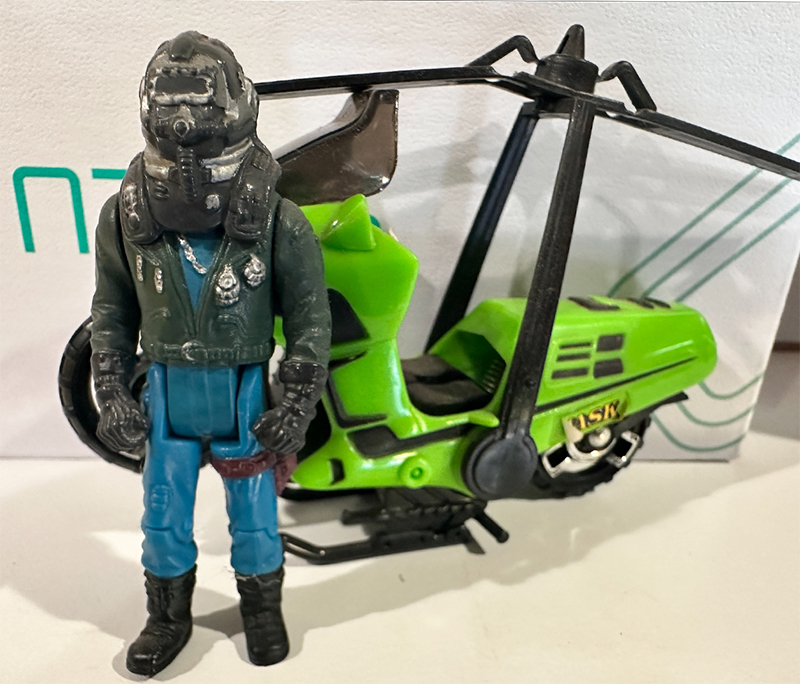It’s 1985. Toy aisles brim with G.I. Joe squads and Transformers combiners—then M.A.S.K. detonates the scene with covert ops, transforming vehicles, and gadget-laden helmets. Kenner’s line stitched together the best of both worlds and still felt fresh: sleek “everyday” rides that flip into combat mode, piloted by a secret team with specialized masks.
M.A.S.K. Origins: Story & Cast
At the center is Matt Trakker—philanthropist tactician leading the Mobile Armored Strike Kommand against V.E.N.O.M. (Miles Mayhem’s crew). Every operative wears a named mask with a unique ability, and every vehicle hides a second, battle-ready form. The premise blended espionage, high-tech warfare, and heroism—perfect fuel for 80s imaginations.
Vehicles & Figures: Transforming Playtime
Kenner designed the line around vehicles first, with ~2.5″ drivers scaled to the cockpits:
- Thunderhawk (Matt Trakker): red sports car whose gullwing doors deploy to transform into a jet.
- Condor (Brad Turner): green motorcycle that converts into a helicopter—compact and wildly swooshable.
- Switchblade (Miles Mayhem): menacing helicopter/jet hybrid that anchored V.E.N.O.M.’s air power.
- Piranha (Sly Rax): cycle with a detachable sidecar submarine for amphibious ambushes.
- Rhino (Hondo MacLean): tractor-trailer bristling with pop-out weaponry and hidden features.
Each driver’s mask added a second play loop—Spectrum (Trakker) for scanning/lasers, Blaster (Hondo) for sonic waves, and so on—so kids were switching modes on both pilot and vehicle.
Boulder Hill & World-Building
The Boulder Hill headquarters playset gave the line a home base—service bays, pop-up defenses, and that signature “rock façade” that flips into fortifications. It’s the classic 80s formula (figures + vehicles + playset) executed with spycraft flair.
The Animated Series: Why It Hooked Kids
Premiering in 1985, the animated series ran for multiple story-packed seasons with globe-hopping missions—desert chases, alpine ambushes, underwater stings. What made it compelling:
- Mission-of-the-week intrigue: espionage setups with gadget reveals kept episodes brisk and re-watchable.
- Character-driven teamwork: rotating specialists (pilots, techs, tacticians) made the team feel bigger than the toys.
- Mask-as-gadget payoffs: episodes framed masks like spy gear—problem → mask ability → clever resolution.
- Anthemic energy: a high-gear theme and crisp action direction sold the fantasy of covert heroes with civilian covers.
The show didn’t just advertise toys; it gave kids a play pattern—assemble a squad, pick the right masks, switch the vehicles, execute the mission.
What Made M.A.S.K. Different
Instead of complex transformer puzzles, conversions were fast and tactile—flip, pop, go. Vehicles felt grounded (sports cars, bikes, trucks) with just enough sci-fi twist to wow. The smaller figure scale put engineering focus where it mattered: the machines.
Collector Notes
- Completeness matters: driver and mask and all missiles/wings. Masks are tiny—often missing.
- Mechanisms: test springs/hinges on Thunderhawk doors, Condor rotors, Switchblade transitions.
- Boulder Hill: check façade tabs, doors, and decals; large panels can warp in heat.
- Rubber & plastics: keep soft parts away from PVC; avoid sun/attic heat to prevent brittling.
- Documentation: instructions and label sheets add value; bag accessories separately.
Enduring Appeal
Though the line wrapped by the late ’80s, M.A.S.K. sits comfortably between G.I. Joe (tactical squads) and Transformers (conversion magic). It’s compact to display, fun to handle, and still sparks that “secret mission” itch. For team mech energy, see also Voltron.
